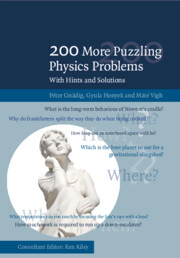Hints
Published online by Cambridge University Press: 05 May 2016
Summary
H1 Consider the motions of the bodies both in the original frame of reference and in another frame that moves with velocity v0 relative to the first one. Apply the Galilean transformation formulae.
H2 Be careful, the transformation principle due to Galileo Galilei applies only to inertial reference frames. The idea that Ann simply observes Bob moving towards her with a speed of 1 m s−1 is false.
H3 It is easier to solve the problem in a frame of reference fixed to the cart. A vector diagram of velocities, superimposed on a geometrical one showing the initial situation, should prove helpful.
H4 It is helpful to describe Joe's motion using a reference frame moving with the river water; imagine that we are in a boat that drifts with the river. Using this frame of reference, a suitable optical analogy and the application of Fermat's principle can help us to find Joe's optimal trajectory.
H5 The description of the disc's motion in a frame of reference fixed to the table is not easy. Try using a reference frame moving with the conveyor belt.
H6 The task can be tackled in several ways. One possibility is to analyse the turning process in an appropriate projection of phase space, namely in the vx– vy coordinate system. Another good idea is to use an inertial frame of reference moving relative to the ice in a suitably chosen direction.
H7 From the tangential and centripetal components of the acceleration, determine the horizontal and vertical ones.
H8 Finding accurate time intervals for the two sections of the motion is very difficult. To answer the question as posed, it is easier to compare an underestimate of the time to cover arc AP with an overestimated time for arc PB.
H9 Show that the axis of symmetry of a parabola makes an angle with the tangent to the parabola at any point P that is half the angle it makes with the line connecting P to the focus.
H10 Instead of using calculus, let us try to solve the problem using a variety of techniques, e.g. by investigating the number of real roots of a quadratic equation, or by using the properties and geometric representations of relevant vectors.
Information
- Type
- Chapter
- Information
- 200 More Puzzling Physics ProblemsWith Hints and Solutions, pp. 65 - 90Publisher: Cambridge University PressPrint publication year: 2016
